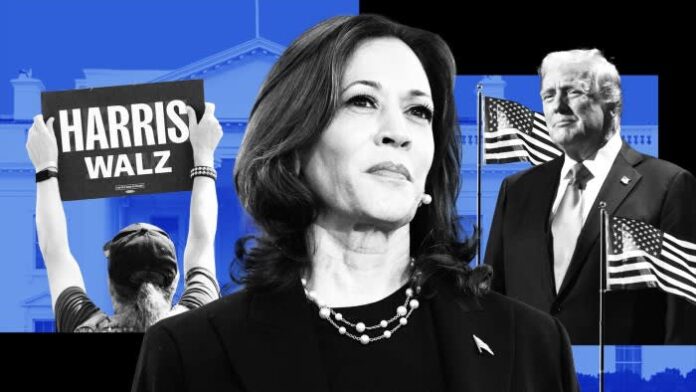Nancy Quarles, the Democratic party chair for Oakland County in the suburbs of Detroit, is a veteran of many political battles in the swing state of Michigan.
But speaking at her office along the 12 Mile Road in the middle-class town of Southfield, she says there is “something completely new” in what has unfolded since Kamala Harris replaced Joe Biden as the Democratic presidential candidate just four weeks ago in the election against Donald Trump.
“Our phones are ringing off the hook. The people want signs [for their gardens]. Our director of operations is inundated with people who want to come in and help,” she says. “There’s been this pent-up wanting to do something, but they just didn’t have the impetus.”
When the Democratic party rallied quickly around Harris after Joe Biden dropped his re-election bid last month, it marked a leap of faith that the vice-president could electrify the centre-left of American politics and revive its chances of stopping Trump from winning a second term.
So far, the wager on Harris has worked. She has caught up with the former president and Republican nominee and is even eclipsing him in national and some battleground polls, in a remarkable turnaround. Trump is suddenly on the defensive after being the relatively comfortable frontrunner for months.
Harris has now held large, boisterous rallies in cities ranging from Detroit to Philadelphia and Las Vegas that have evoked Barack Obama’s first presidential campaign in 2008, and raked in more than $350mn of fundraising, which is allowing her to launch advertising campaigns across the country.
The launch of her campaign has gone as well as anyone in the Democratic party could have hoped as she has satisfied the demand of many voters for a fresh face in the race. But now the second phase is about to begin and this will involve much bigger hurdles.
The Democratic National Convention, starting today in Chicago, will be capped by Harris’s speech accepting the party’s presidential nomination on Thursday night. After that she will be under pressure to keep this surge of Democratic support alive in the face of potentially sharper attacks from Republicans, greater scrutiny of her policy plans and unscripted interactions with the public.
Donna Brazile, a veteran Democratic strategist and former party chair, still thinks Trump has the advantage in the race against the vice-president: “She has to make a clear and convincing case that she cares about people’s concerns.”
For now though, Harris has Trump scrambling — and struggling — to craft an effective message against her, as the two campaigns fight to define her in the eyes of voters with little time to spare before the November election.
In Michigan, one of a trio of swing states along with Pennsylvania and Wisconsin known as the “Blue Wall” that is likely to decide the election, Democratic lawmakers are optimistic that she can pull off a victory. But they say it will not be easy.
“Kamala Harris has a lot of energy and momentum,” says Haley Stevens, a Democratic lawmaker from Michigan representing Oakland County. “My goal is to have record turnout, and we’re going to need to dig deep for that . . . to pay attention to the still undecided voters.”
Dan Kildee, a Democratic lawmaker representing the area of Flint, north of Detroit, says Harris’s challenge will be to “get specific” on policy proposals while keeping up the positive aura surrounding her candidacy.
“In some ways, the compressed nature of this candidacy makes it easier to sustain,” he says. “This is a 400-metre sprint, not a marathon.”
In little less than a month, and despite being the second-in-command of the US government, Harris has been able to position herself as the candidate of change in an election in which voters were desperately searching for an alternative to both Biden and Trump.
At 59, she is nearly 20 years younger than Trump, who is 78, and would be the first woman to serve as US president if elected. Her campaign speeches are shorter by comparison — often lasting less than 30 minutes — and they are far more direct in attacking Trump than Biden’s were. Her delivery is also clearer and sunnier.
“[This campaign] is about two very different visions for the future of our nation: one, ours, focused on the future, and the other focused on the past,” she said to the audience of about 15,000 that assembled at Detroit’s airport on August 7, where she was flanked by her vice-presidential nominee Tim Walz, the governor of Minnesota. “In this fight, we are joyful warriors,” she added.
…. (content continues)




